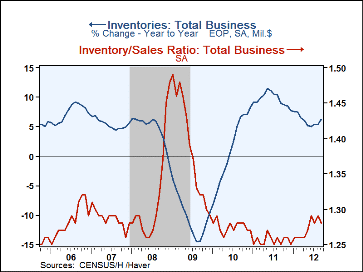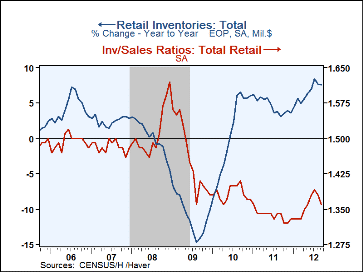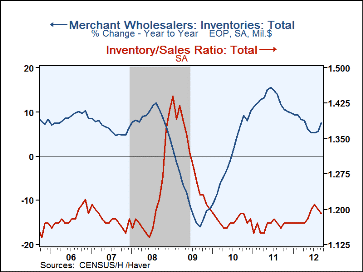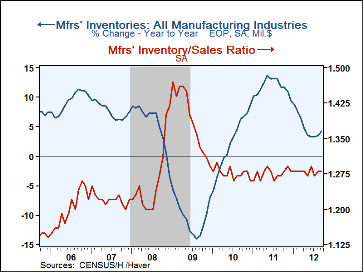 Global| Nov 14 2012
Global| Nov 14 2012U.S. Business Inventory Growth Remains Steady
by:Tom Moeller
|in:Economy in Brief
Summary
Business inventories rose 0.7% following a 0.6% August rise. Quickened accumulation during the last three months reflected the gains in merchant wholesalers inventories driven by a 5.5% surge (11.9% y/y) in petroleum inventories. [...]
Business inventories rose 0.7% following a 0.6% August rise. Quickened accumulation during the last three months reflected the gains in merchant wholesalers inventories driven by a 5.5% surge (11.9% y/y) in petroleum inventories. Petroleum inventories also rose 10.2% in August. Elsewhere, wholesale inventories increased a firm 0.9% (7.2% y/y) during September. Inventories at the retail level gained a modest 0.3% (7.6% y/y). That was led by a 0.9% jump in autos (20.2% y/y) after a 1.2% August increase. Nonauto retail inventories were unchanged for the second consecutive month. Factory inventories rose a steady 0.6% (4.1% y/y).
Business sales jumped 1.4% led by an 8.3% (13.1% y/y) rise in wholesale sales. Wholesale sales increased 0.8% (2.8% y/y) without petroleum and the inventory-to-sales ratio remained a roughly constant 1.28. Retail sales surged 1.3% (5.4% y/y) as auto sales jumped. Excluding autos, sales increased 1.2% (4.5% y/y). As a result, the nonauto retail I/S ratio slipped to 1.18. Factory shipments gained 0.9% leaving the I/S ratio constant at 1.28.
The manufacturing and trade data are in Haver's USECON database.
| Business Inventories(%) | Sep | Aug | Jul | Sep Y/Y | 2011 | 2010 | 2009 |
|---|---|---|---|---|---|---|---|
| Total | 0.7 | 0.6 | 0.8 | 6.2 | 7.7 | 8.3 | -9.4 |
| Retail | 0.3 | 0.4 | 1.1 | 7.6 | 3.6 | 6.1 | -10.1 |
| Retail excl. Motor Vehicles | 0.0 | 0.0 | 0.4 | 2.8 | 3.7 | 3.9 | -4.8 |
| Merchant Wholesalers | 1.1 | 0.8 | 0.6 | 7.5 | 9.9 | 10.1 | -11.8 |
| Manufacturing | 0.6 | 0.6 | 0.6 | 4.1 | 9.4 | 8.8 | -6.8 |
| Business Sales (%) | |||||||
| Total | 1.4 | 0.6 | 0.9 | 4.4 | 11.3 | 9.7 | -14.8 |
| Retail | 1.3 | 1.1 | 0.8 | 5.4 | 8.3 | 5.8 | -7.9 |
| Retail excl. Motor Vehicles | 1.2 | 1.0 | 0.9 | 4.5 | 7.6 | 4.7 | -6.4 |
| Merchant Wholesalers | 2.0 | 1.0 | -0.2 | 4.4 | 13.5 | 11.6 | -16.2 |
| Manufacturing | 0.9 | -0.2 | 1.9 | 3.7 | 11.8 | 11.2 | -18.8 |
| I/S Ratio | |||||||
| Total | 1.28 | 1.29 | 1.28 | 1.25 | 1.26 | 1.27 | 1.39 |
| Retail | 1.36 | 1.38 | 1.39 | 1.34 | 1.34 | 1.38 | 1.46 |
| Retail Excl. Motor Vehicles | 1.18 | 1.20 | 1.21 | 1.20 | 1.21 | 1.24 | 1.30 |
| Merchant Wholesalers | 1.19 | 1.20 | 1.21 | 1.16 | 1.16 | 1.18 | 1.31 |
| Manufacturing | 1.28 | 1.28 | 1.27 | 1.27 | 1.27 | 1.28 | 1.39 |
Tom Moeller
AuthorMore in Author Profile »Prior to joining Haver Analytics in 2000, Mr. Moeller worked as the Economist at Chancellor Capital Management from 1985 to 1999. There, he developed comprehensive economic forecasts and interpreted economic data for equity and fixed income portfolio managers. Also at Chancellor, Mr. Moeller worked as an equity analyst and was responsible for researching and rating companies in the economically sensitive automobile and housing industries for investment in Chancellor’s equity portfolio. Prior to joining Chancellor, Mr. Moeller was an Economist at Citibank from 1979 to 1984. He also analyzed pricing behavior in the metals industry for the Council on Wage and Price Stability in Washington, D.C. In 1999, Mr. Moeller received the award for most accurate forecast from the Forecasters' Club of New York. From 1990 to 1992 he was President of the New York Association for Business Economists. Mr. Moeller earned an M.B.A. in Finance from Fordham University, where he graduated in 1987. He holds a Bachelor of Arts in Economics from George Washington University.










